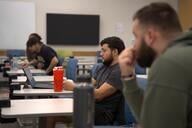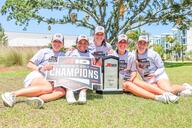You have /5 articles left.
Sign up for a free account or log in.

Seven in 10 students in this quarter’s Student Voice survey say the top benefit of participating in extracurriculars is meeting new people or making new friends, and this is relatively consistent across institution types and student subgroups.
Kar-Tr/iStock/Getty Images Plus
As coverage of our third Student Voice survey of 2023, on the college experience, wraps up, read on for a recap of the top 10 findings and links to related articles and analysis.
The survey, circulated in July and August in collaboration with College Pulse, included 3,000 two- and four-year college respondents at 170 institutions. Questions related to experiences with orientation and college onboarding, involvement in extracurriculars and campus events—including why students get involved and why they don’t—and what technology might boost students’ participation. Explore the data more by requesting access to findings, with the ability to filter by demographic factors, here.
Now, the survey’s biggest takeaways:
- Orientation isn’t one-size-fits-all.
The vast majority (2,802) of the survey’s 3,000 two- and four-year respondents attended their new-student orientations, and 73 percent rate their orientation experiences as good or excellent versus fair or poor. But format matters, and it’s not a one-size-fits-all issue, with two-year college students rating virtual orientation experiences much more favorably than four-year students.
Experts say this highlights the importance of knowing one’s students and tailoring orientation to their input and needs. For example, about six in 10 four-year students (59 percent) say orientation should include social events, compared to just a third (33 percent) of community college students.
Another thing to consider: orientation expectations don’t necessarily match outcomes. Nearly half (47 percent) of students in the overall sample think orientation should cover mental health, but just about a quarter say that their orientations effectively familiarized them with available mental health resources.
- Orientation satisfaction rates are on the rise.
Orientation satisfaction rates unsurprisingly dipped during the pandemic, but they’re increasing again and even exceeding orientation satisfaction rates for the Class of 2023, many of whom started college in 2019, before the pandemic. (Some 81 percent of the Class of 2026 says their orientations were good or excellent, versus 71 percent of the Class of 2023, 66 percent of the Class of 2024 and 73 percent of the Class of 2025.)
One possible explanation? Some institutions are taking a back-to-basics approach to orientation for what’s been described as Gen P, or the pandemic generation. This means focusing on essential knowledge for the first few weeks on campus and on community norms and peer-to-peer interaction, instead of taking a kitchen-sink approach. In some cases, colleges and universities have shortened their synchronous orientation events and created online modules for what can’t be covered live.
- Specialized orientation experiences offer real benefits.
College onboarding satisfaction rates are especially high for specialized group experiences, including summer bridge programs. Some 86 percent of the approximately 100 students in the survey who completed a summer bridge program say their onboarding experience was good or excellent. Bridge alums also have better orientation outcomes than other first-generation and even continuing-gen peers, especially in the areas of academic preparedness and social connection. For instance, 56 percent of bridge alums say their onboarding experience helped them feel more prepared for college versus 39 percent of first-gen students who didn’t complete a summer bridge and 40 percent of continuing-gen students with no summer bridge.
A third of first-gen and continuing-gen students alike also say it’s important to include specialized programs and events for first-gen students in orientation. About the same share of students says orientation should include specialized programs and events for students of color. This is consistent across major racial groups.
- There are disparities in campus involvement levels.
A third of students spend no hours weekly on extracurricular activities, and half spend one to five hours. Looking deeper, there are concerning differences in students’ campus involvement. More than half (55 percent) of two-year college students spend zero hours a week on extracurriculars compared to a quarter (24 percent) of four-year college students, for instance. Students at public institutions spend less time on extracurriculars than students at private institutions, and first-gen students spend less time than their continuing-gen peers.
Other participation gaps involve gender, financial aid status, employment status and race. Hispanic students in the survey have lower levels of involvement than other major racial groups: 40 percent of Hispanic students spend zero hours per week on extracurriculars, and they’re also the most likely group to be working full-time. Student success experts say that promoting involvement outside the classroom is an equity issue, because campus involvement, like classroom engagement, is linked to various student success metrics.
- Students face various barriers to participation in campus life.
More than two in five (41 percent) students say timing and location of events is a top barrier to participation in extracurriculars and campus events. Nearly two in five students (36 percent) also cite off-campus work as a barrier to involvement in campus life. On-campus work is another barrier for many, though some students and institutions view on-campus work as a potential gateway to involvement.
Students with financial aid appear to be disproportionately affected by these and other factors when compared to students without financial aid, again posing equity concerns. Some 32 percent of students with financial aid cite lack of knowledge about activities and events as a barrier to participation, compared to 25 percent of students with no financial aid.
- Students participate in extracurriculars primarily for social reasons.
Seven in 10 students say the top benefit of participating in extracurriculars is meeting new people or making new friends, and this is relatively consistent across institution types and student subgroups. A sense of belonging and activism and being part of one’s community are distant seconds at about a quarter of students each. Just 13 percent of students say they do extracurriculars to have activities to put on their résumés. And just 14 percent of students say they’d participate in clubs and other extracurriculars more if they had the option to participate virtually, suggesting that students are eager for face-to-face experiences in this area of their lives.
Existing research indicates that involvement is about quality, not quantity, and that sustained involvement in even one or two meaningful activities makes a difference to student success and well-being.
- There are gaps in leadership-position experience.
Students who enter college with certain advantages accrue additional advantages in college, including, in this survey, leadership-position experience. There’s an inverse relationship between students’ economic backgrounds and leadership-position experience, with just about a quarter (26 percent) of lower-income students having held a designated leadership role in college, versus a third (33 percent) of middle-income and nearly half (48 percent) of higher-income students.
Similarly, first-generation college students are much less likely than their continuing-generation peers to have held a leadership position in college. However, leadership experience isn’t only gained in explicit leadership roles, experts say, and all students need help recognizing and articulating the leadership skills they’ve gained in college.
- Students want specific kinds of help with time management.
The top resource students say would improve their time management is the ability to combine different syllabi to organize deadlines, with more than two in five (42 percent) students choosing this from a list of eight options. That’s relatively consistent across institution types and student groups, but students who work full-time are especially likely to say this. About a third of respondents each say they’d benefit from the following, with these options being more popular among four-year college students than two-year students: help planning their individual schedules, social support or social structures like study groups or quiet hours in residence halls, and time management tips and workshops. Just about one in five students says nudges via text or email from faculty or staff would help.
Student success coaches say time management is a core executive function that’s still developing in traditional-age students and also part of the hidden curriculum of college. But at least as far as campus involvement is concerned, just 13 percent of Student Voice respondents say that institutional help with time management would boost their participation in extracurriculars and events.
- Students want better promotion of campus events and activities.
A campus events calendar is the No. 1 feature students want in a campus app, whether their institution has one or not, with 60 percent of students choosing this. No. 2 and No. 3 priorities for campus apps are notifications and reminders about campus events (43 percent) and personal schedule management (38 percent), respectively. This was just one of several places in the survey that students report having missed out on extracurriculars and events because they simply didn’t know about them.
- There’s some appetite for virtual participation in campus events.
Asked what technology would help increase their participation in campus events, such as guest speakers, sporting events, workshops, half (50 percent) of students say the ability to participate virtually (this is separate from extracurriculars, on which most students weren’t enthusiastic about virtual participation options). Close second options are the ability to plan or receive notifications from a campus app (42 percent) and getting credit or other incentives for attending, such as a LinkedIn badge (42 percent). Virtual participation options for events appear to be especially popular among older students: some 68 percent of the approximately 100 students in the sample age 30 to 39 express interest in these, versus 48 percent of the 1,834 respondents age 19 to 23.
Browse results of past Student Voice surveys here.





